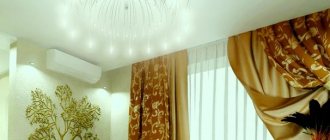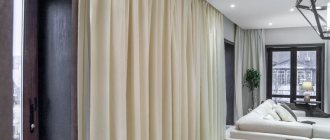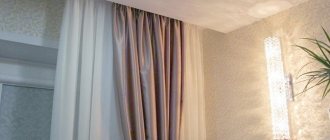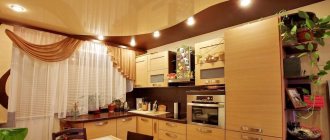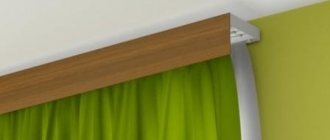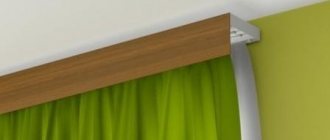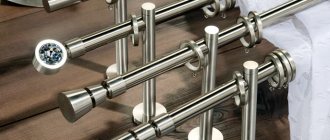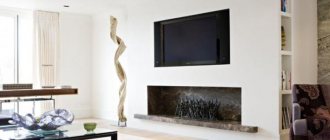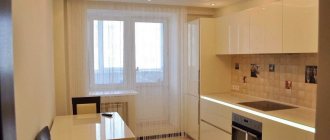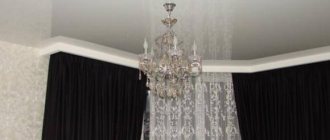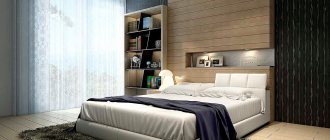There are a large number of attributes in a living room that complement it and create the overall look of the room. The cornice on which the curtains are attached does not always suit the interior design. A niche made according to an original design will come to your aid. It is able to hide the curtain rod, hooks, rings and other curtain fastenings from prying eyes. It's practical and convenient. You can create the impression of a curtain descending from the ceiling itself. Niches are usually made from plasterboard. This material has all the necessary qualities for constructing a niche of any complexity.
Why do you need a plasterboard niche under the cornice?
If your room has beautiful wallpaper, plastic double-glazed windows, and suitable curtains, then you should think about a plasterboard niche. The curtain itself looks beautiful, but the tire can spoil its entire appearance. Therefore, niches were invented for room decoration.
You should not use wallpaper to hide plastic curtain rods. This finishing option does not always look good. Usually it looks ridiculous and rude.
Using a niche, you can hide a cornice from which curtains are hung using rings or hooks. And do it beautifully and correctly. If the room has glossy stretch ceilings, a niche can hide the entire curtain mounting structure, and it will not be reflected in them.
A plasterboard niche can perform two functions:
Niches are used to disguise wires if you have electric blinds. In this case, you can hide everything under the box. The block with the mechanism will look ugly if it is not hidden.
Ceiling niche length.
This size L between the left and right edges of the niche depends on its location - near the window, along the entire wall (the length of the niche is determined by the size of the wall), from one edge of the window to the opposite wall and vice versa. To be specific, let’s take the “near the window” option. In this case, the niche should extend beyond the window opening on the left and right. The question is - for how long?
Let’s assume that you have a small window relative to the size of the wall, and you don’t want thick curtains opened during the day (we selected them earlier for definiteness) to block it, reducing the flow of light. In this case, the niches overhanging the window opening should be at least 50 cm in order to provide enough space for the gathers of porter fabric.. But if you are determined to hang a Roman blind on this window, instead of our option, then 10 cm will be enough for each approach That is, we again observe the dependence of the size of the niche on the selected curtain model.
Another nuance: if your non-standard window sill has edges that extend far into the walls, then the length of the niche should be such that our curtains can then hide these edges. In connection with this, too, another case from my practice is indicative. I came across this version of windows with irregular niches in the hall of my customer’s cottage:
The lengths L1 and L2 of the two niches are such that in three places they end clearly at the level of the walls of the window opening, completely ignoring the significant overlap of the window sills onto the partitions... That is. only the left end, reaching almost to the wall, near the niche of the first window, is correct. How they came to such forms - history is silent. This is how I managed to level out the existing niche disadvantages in this case:
With the thin profile cornice mentioned at the very beginning, I imitated the continuation of the niche to the right for the second window and covered the entry of the window sills onto the partitions. Curtains can fix a lot of things... including the ceiling niche...
Extending the niche to one of the walls (or to both), thereby increasing the length L , makes sense if you want to hide on the wall with curtains something that could not be hidden structurally during the renovation. Or maybe you like beautiful curtain fabric flowing from the ceiling all over the wall...
Instructions: how to attach a cornice to drywall
You previously made plasterboard ceilings in the room, and now you decided to hang curtains. It is necessary to secure the cornice to the drywall correctly and efficiently so as not to damage the ceiling. You can secure the cornice yourself by following the installation instructions.
Initially, you need to look and figure out how to properly install the mount. Attach the wooden beam to the ceiling in advance, in the place where the future cornice will be located before installing the plasterboard sheets on the ceiling.
Instead of a wooden beam, you can use a metal profile to mount the cornice on a plasterboard ceiling.
Then secure it with screws or self-tapping screws. If the installation of sheets has already been completed, but the position of the cornice does not coincide with the profile, there are ways to secure the cornice without damaging the surface of the drywall.
A hidden cornice adds mystery to the interior and makes it perfect. What do you need to know when installing it? Answer on the website: https://homeli.ru/remont-i-otdelka/potolok/natyazhnoj/skrytyj-karniz-v-natyazhnom-potolke
The cornices are mounted on the wall or ceiling. There is no difference in installation between these two methods. Only some are fixed to the wall, and others to the ceiling.
To install the cornice on the ceiling, you should use additional fastening between it and the plasterboard sheets.
Let's start the installation. To do this you will need the following:
- Ladder;
- Hammer;
- Hacksaw;
- Safety glasses and gloves;
- Construction tape and level;
- Hammer;
- Screwdrivers, pliers;
- Drywall dowels (and several butterfly type pieces);
- Pencil and square.
If you plan to hang heavy curtains on this curtain rod, you should use reliable anchor bolts for installation.
First, we make markings 10-15 cm above the window. Draw a straight line using a building level and rulers. We put marks on both sides of the window - the places where we will install the brackets. We securely fasten the brackets. Then we hang the cornice.
Preparation
You need to start by purchasing materials. For this you will need:
- plasterboard sheets;
- two types of profiles: ceiling PP 27x60 and guide PN 28x27;
- self-tapping screws;
- tape for sealing joints;
- putty.
- perforator;
- screwdriver;
- knife;
- putty knife;
- tape measure and pencil;
- strong thread.
Applying markings is a very important moment. It is based on the correct location of the cornice (and, accordingly, the niche) relative to the window sill or heating radiator. The first relative to the others should be located inside the living room by 15-16 cm. Therefore, knowing the dimensions of the protruding part of the window sill or radiator and adding 15 cm to it, we obtain the distance of the place where the cornice is attached from the wall in the living room.
We transfer this size along the ceiling along the two side walls. Now, by attaching the ends of the paint cord to the two resulting points, we get an even line on the ceiling, parallel to the wall. This is the end of the niche for plasterboard curtains and the beginning of the decorative box.
From this line we set aside the width of the box you have accepted inside the living room, and draw another line. So, the installation dimensions of the box for the niche under the cornice are there. You can proceed to assembling the frame.
How to make a niche for curtains from plasterboard with your own hands
When starting work, you first need to decide on the size of the niche. Determine its width and depth, position relative to the planes. We make marks. We beat off two strips on the walls and one on the ceiling with a polished thread. The indentation should be at least twenty centimeters. On this marking we install metal profiles (guides). For this, screws and plastic dowels are used.
At the second stage, we attach the ceiling elements of the frame. We insert the guide profile inside. We fix it with hangers on the outer side. We fasten it using self-tapping screws. On the line that was previously beaten off with thread, we drill holes. We insert dowels into them. Suspensions are attached to them, and another profile is installed.
We fasten the strip of drywall with self-tapping screws, passing through the frame elements.
In advance, you need to make recesses in the plaster at the place where the vertical sections of the guide profile are attached.
We assemble the base of the vertical wall of our niche:
- Take the base;
- We attach a strip of drywall to it;
- We connect the ceiling profile and the guide using the sides.
The ends of the guide must protrude beyond the ends of the profile by at least twenty centimeters.
Afterwards we assemble the wall of the niche. We install the niche wall on a plasterboard platform.
At the very end we do the finishing work. We putty the corners and fixation points.
But string cornices are easy to mount independently both to the wall and to the ceiling. All information is in our material: https://homeli.ru/dekor/shtory/strunnyj-karniz
Ceiling plinth, as an option to hide the cornice
Decorating the ceiling with a plinth or baguette is an original way to completely hide the junction of the curtain with the ceiling. Backlighting is often placed there - the light bulbs themselves, LED strips will be invisible, the observer will only see their light. The lighting itself is hidden in a niche, parallel to the curtain rod, decorating the space of the room.
The baguette itself is executed:
- wooden - decorated with carvings, painted with stain, paint, found in Art Deco and classical styles;
- metallic – it is a smooth shiny strip, well suited for high-tech and industrial interiors;
- polystyrene foam - made white, painted, smooth or textured, ideal for minimalism, modern style;
- made of plaster - such a border is made extremely rarely, as it is complex in design, heavy in weight, suitable for baroque and antiquity.
Guides of baguette design are plastic, steel, aluminum, and sometimes strings. Typically, such a curtain is attached in almost the same way as other options. It is possible to attach it to a built-in beam - then the cornice, which in normal condition is clearly visible, is hidden behind a decorative plinth, which anyone can choose.
How to attach a curtain to drywall with your own hands
Many people use drywall to decorate their walls. But we periodically put different things on the walls: shelves, cabinets, decorative panels and curtains. Objects should be mounted on such walls correctly, taking into account all the nuances of the finishing material.
Decorating a corner window with curtains always looks impressive. This requires a special cornice. All the details are in our next article: https://homeli.ru/dekor/shtory/uglovye-shtory
To attach curtains to plasterboard walls you will need the following tools:
- Construction tape and level;
- Screwdrivers;
- Bracket.
Having all these necessary tools, you can install the curtains yourself in a few minutes.
Let's get to work. First we make marks where the curtain itself will be located.
The main thing is that the cornice does not interfere with the opening of the windows. To do this, you need to place it at a distance of 15 cm from the window.
Draw a straight horizontal line. Attach the brackets at the same level from the window to the plasterboard wall. The curtain itself is mounted on anchor bolts. In advance you must make holes in the plasterboard sheathing for them.
Adviсe
When creating a niche, you can make it more attractive by following some tips.
- Curtains illuminated with LED strip look unique. Using a special remote control, the lighting changes color, creating an emotional mood for each individual moment.
- A niche looks more impressive if it is assembled along the entire wall. But if you select only the window, you can save on building materials.
- The opening for curtains does not have to be an invisible gap in the ceiling; it itself can be a decorative element of the interior. It is highlighted with color, lined with mirrors, decorated with moldings and a wide ceiling molding.
- You cannot make mistakes when calculating a niche; a niche that is too narrow can squeeze and deform the line of curtains, and a wide one can create a hole in the ceiling space.
- Rooms separated by ceiling openings for curtains can be zoned not only with soft curtains; The best division of space is Japanese curtains.
How to mount a plasterboard niche for curtains (video)
Niches for curtains made of plasterboard in the form of a box are often found in various rooms. Such a decorative element in the interior can hide the structure with which curtains are attached and moved along the curtain. Niches perform a large number of functions. You can install the niche correctly with your own hands if you follow the instructions during the work.
If a design project is being carried out in an apartment or house, then everything is done beautifully, in a new way. A niche for plasterboard curtains hides the cornice on which the curtains are hung. This option visually lengthens the window, making the room larger and more spacious. In order to make such a niche for curtains from plasterboard with your own hands, you make a box from gypsum plasterboard, which is mounted at a distance of 20 cm from the wall above the window.
Full contents of the material
A box is not a niche - definition of concepts
When they talk about creating a cornice using drywall, they often mean the box. If in the case of creating a niche the top of the curtains is hidden in a recess, then in the case of a box it is hidden behind the newly designed design. At first glance, it may seem that creating a box will ruin the look of the room, especially if the ceiling is single-level. But this is not true, although everyone has different tastes.
A plasterboard cornice does not have to be attached to a suspended ceiling
A gypsum plasterboard cornice can be attached either to a finished suspended ceiling or to a bare ceiling. The second solution can only be applied if the ceiling is flat, and this is not often the case. Sometimes, when creating a suspended ceiling, they prepare in advance to create a box. Therefore, a profile is added to the design, to which a plasterboard cornice for curtains will later be attached.
A niche must be provided at the time of creating the frame for the suspended ceiling. In the case of a box, this is not necessary. Although it doesn’t hurt to think about its use in advance.
We will consider the process of creating a box that plays the role of a cornice.
Types of plasterboard niches for curtains
There are 2 types of boxes: wide, narrow. The first option involves backlighting. The box is 50 cm wide, the depth of the niche for curtains will be 10 cm. The box for the niche is assembled in the usual way, starting with a drawing and collecting materials. After installing the frame, the box is covered with plasterboard and puttied. After puttying, the niche is covered with wallpaper or painted to match the color of the ceiling.
Option for a large niche for gypsum plasterboard curtains with lighting
Narrow box. Applicable if there is no spot lighting near the curtains. A narrow box is made, and a baguette is attached to the front side. The height of the box must match the width of the cornice.
Example of a narrow curtain box
The width of the box reaches 5 cm, no more. The technology for installing such a niche differs from the standard plan according to which the box is made. There is another option for a niche: combining a wide box and using a cornice.
Sheathing with plasterboard
It is necessary to sheathe the box with plasterboard only from the bottom and front sides. Therefore, several strips are cut from the sheet. Some will be as wide as the width of the box for the plasterboard niche for the cornice, while others will be as wide as the height of this box. Fastening is done with self-tapping screws using a screwdriver.
There is no point in sheathing the back part of the structure; it will not be visible anyway. Now you can install a hidden cornice in a niche made of plasterboard, and finish the box itself with putty and carry out sanding and further finishing.
So, in the question of how to make a niche from plasterboard in the living room, all the i’s are dotted. This is the simplest option. If any of our readers have any questions or ideas, we are ready to discuss them with you on this page in the comments.
Design features: drawings and calculations
In order to start designing on paper, and also begin calculating materials, you should decide on the height of the box for the plasterboard niche. The height of the curtain rod will help with this. If it is a plastic strip attached to the ceiling on which curtains are hung, then you need to choose whether there will be lighting near the window or not.
There is an option when a niche for curtains is made using a figured multi-level ceiling, then the height should not be determined, since the ceiling structure itself will serve as a niche.
Let's say there is no figured multi-level structure on the ceiling. The box will be narrow, across the entire window. From this structure to the wall above the window is 20 cm. In this case, the curtains are supposed to be light, without heavy ones, completely blocking daylight. The width of the box itself will be 5 cm and the height 8 cm. In such a niche for curtains, the box is sometimes illuminated by installing ice tape.
To establish the distance from the wall to the box:
- One thing to consider is how the curtains are hung. So that they are not pressed against the wall above the window.
- The LED strip on the ceiling is attached between the curtain hanger and the inside of the box.
Built-in LED strip for curtain lighting
One way or another, the niche must have sufficient space for working with curtains (replacing them, their care - washing). After determining the width between the wall and the box, the sketch is drawn on paper and the control points and lines are transferred to the ceiling. From the drawing it becomes clear how much material is required for this production.
Watch the video: installing a plasterboard niche for curtains.
Required tools and materials
To create a niche from plasterboard, in addition to the main material, you will need:
Interior design options
Hidden curtain rods are an excellent solution and almost the only one for rooms with angled ceilings (monsard). The traditional method of fastening the cornice in such cases does not look very nice. Hiding it from view is the only correct solution.
Which is better: heated floors or radiators?
Warm floorBatteries
If the budget allocated for repairs allows, then you can make original lighting as in the photo. Lighting can be installed both inside and outside the curtains. This solution puts emphasis on the window area and allows you to use this space separately. For example, use for a desk or relaxing with a book.
A hidden curtain can also be used to create a canopy over a sleeping area. The room takes on a more aesthetic appearance, because the fastening design does not stand out from the overall interior. A cozy and romantic atmosphere is created if dim lighting is used in this niche.
Preparatory work
You should not start installing the frame right away; first you need to carry out preparatory work. Clean corners, walls, and ceilings from swollen old plaster, whitewash, and wallpaper residues. If, after getting rid of everything, holes appeared, the surface became uneven. Then you need to clean everything from dust and prime it.
Using putties and putties, remove unnecessary grooves and achieve a smooth surface. Draw all control points of fastenings, lines along which the profiles will be mounted.
It is required to apply points and lines evenly, without bevel. Because the profile will also lie crookedly, the design will not be ideal. Suspensions are pre-made from PP. Their size is equal to the height of the box minus 1 cm.
Niche design: creating lighting
It was noted that in addition to the main function, the box allows you to integrate lighting. The organization of additional lighting will look unusual and attractive. The lighting will create the effect that the curtains are airy. To achieve this goal, a strip with LEDs is inserted into a special groove. It can be any color; you don’t have to choose a classic one. This also helps to visually increase the height of the space. Relevant for low rooms.
@remontoffanapa.ru
The box for the curtain rod allows you to hide the auxiliary elements and leave only beautiful curtains for the eyes. There are several methods to implement such a project. One of them can only be performed by professionals. Therefore, if you plan to carry out the work yourself, it is worth taking into account the peculiarities of the methods for creating a recess.
The construction of the box should be planned at the ceiling design stage. Otherwise, it will be impossible to implement such an idea later. A strip of lighting will create an airy effect and add light to the room.
Stages of work
When installing the device frame, the order of work should be observed. The practicality of a plasterboard niche depends on this. So:
- Using a meter and a marker, markings are applied. Lines for profiles should be laid out taking into account sizegypsum board thickness. 2 lines will appear on the ceiling: the inner wall of the niche is 20 cm, the outer wall is 25 cm from the wall near the window.
An example of marking the walls and ceiling for a plasterboard structure for curtains
- Guide profiles are attached along the lines marked on the horizontal window. Fasteners should be every 25-30 cm. For this, dowels and nails 6/40, 6/60 are used.
- A section of profile with a height of 8-1=7 cm is attached to the edges of the guide profiles. It is fixed to the wall using dowel nails.
- The same sections made from the ceiling profile (7 cm) should be attached to the guide profiles with fleas every 30 cm.
- Bottom of the frame. A guide profile is fixed to the vertical suspensions horizontally to the one on the ceiling. When fastening, an exact angle of 90 degrees should be observed. A square is used for this.
- Since the niche for curtains is 5 cm thick, there is no need for jumpers between the guide profiles.
This angle is made at 90 degrees. For this, a square or level is used.
if the niche is created narrow, then it is not necessary to make jumpers at the bottom. Now drywall. Using a construction knife, parts of the plasterboard are cut to the dimensions of the frame. The drywall fastening goes like this:
- Frame trim on the window side. Fasteners should be pressed into the drywall so that they are not above a flat surface;
The frame is initially covered with plasterboard on the window side, and then externally.
If lighting is provided, care should be taken to provide wiring under the drywall. The wires must be removed from the frame by 15 cm. The video shows the process of making a niche for a curtain from plasterboard.
We recommend watching the video: installing a niche for curtains in a plasterboard box.
Features of a niche in a suspended ceiling
The height of the ceiling will visually increase even more if the tension fabric is glossy. The curtains will flow from the reflection. When ordering work from craftsmen, the presence of such niches is usually discussed, and the installation work is carried out by professionals.
But you can do the design yourself, here you will need the following sequence:
- First of all, it is necessary to carry out all the work with wiring, lighting and illumination, if they are suggested by the design.
- The cornice is fixed to the ceiling using dowel nails with a plastic sleeve. So, it will be easy to determine the size of the future niche. Afterwards, the structure must be covered with polyethylene to prevent damage during installation of the box.
- The construction of a niche begins with the assembly and fastening of the base. It is necessary to indent a few centimeters from the cornice and nail a wooden beam. In this case, it is necessary to take into account: the level of the lower edge of the beam must coincide with the indentation on the other walls so that the tensioned surface is without slopes. Wedges are used for leveling.
- Fastenings for the future stretch ceiling are mounted on the inside of the tree. As a result, you should end up with a niche for the cornice; you can only notice it at close range.
A distance of −50-100 cm from the window opening is absolutely not noticeable, especially when finishing the niche with curtains.
Finishing the niche
After covering the frame of the box, you should begin finishing. First, the fastening points are masked, as well as the seams of the gypsum board sheets are sealed. Reinforcing tape is used for joints. Afterwards, the entire structure is treated with “Finish” putty. After complete drying, each piece of the box is carefully inspected in bright light for any defects. When they are found, a thin layer of putty is applied again.
Before covering the structure with the finish, you should reinforce the joints and putty the fasteners
After the next drying, grouting occurs using sandpaper. All unnecessary small pebbles and strips are removed. The baguette sits on the glue on the front side. In order to paint the box or put wallpaper on it, you should prime the plasterboard box. After drying, you can begin painting to match the ceiling or wallpapering, as well as installing the LED strip and connecting it to the network.
It is often difficult to harmoniously fit the cornices on which the curtains are attached into the interior of the room. The problem becomes more complicated if you plan to make suspended ceilings: you need to think in advance and arrange the fastening of heavy curtains or curtains. In addition, all these elements will be reflected on the glossy surface of the ceiling, which does not look very nice. The solution may be to install a special niche for plasterboard curtains, which will not only hide unwanted elements, but also add elegance to the room.
Pros and cons of hidden design
Before choosing a really good curtain rod, you need to evaluate the advantages and disadvantages of hidden options. There are few disadvantages, but they are significant. This is a high price, as well as the fact that only a professional can install the model. You should think about fastening the curtains in advance even at the time of installing the stretch ceiling.
There are many more advantages, it is because of them that the suspended hidden cornice has become so popular:
- Original attractive design. The combination of ceiling panels and curtains will look great, without visual separation by baguette.
- A niche allows you to hide various communications and even add lighting or other decor to the room.
- The ceiling can be absolutely anything. Multi-level modern designs look great.
- Visually, this design increases the height of the room, making it more spacious visually.
The structure can be built into any room. It will be appropriate in the living room, bedroom, nursery or kitchen. This option is often used in offices, salons and shops to decorate the interior.
https://youtube.com/watch?v=_R_rRahhVdw
Niche options for curtains
First of all, it should be noted that each project for the hidden location of a cornice associated with the construction of a gypsum plasterboard box is unique. When planning a niche for curtains, the characteristics of a particular room are taken into account:
Therefore, the dimensions of the box, especially its depth, are determined individually for each room. There are three main options for niche execution:
- Spotlights are usually mounted in a box 25–30 cm wide.
- The narrow design, 5–7 cm wide, does not provide for the installation of additional lighting, with the exception of an LED strip for illuminating curtains. For beauty and smooth transition, a baguette is glued from inside the room. The height of the structure should be slightly higher than its width or equal to it.
You can create beautiful lighting with any type of niche design. The LED strip is placed between the cornice and the plane of the box facing the window, which increases the width of the niche by at least 2 cm. The LED control elements and the electrical supply are retracted inside the box.
- Wide box decorated with baguette.
Depth of the ceiling niche.
With depth, everything is simple... Its minimum value G should be such as to hide, as we agreed above, the folds of the curtain tape. We calculate: the thickness of the cornice h (~ 1.5 cm) plus the height of the tape s (from 5 to 15 cm, depending on the type of tape) plus the correction u (~ 8 cm) to compensate for the angle of the ray of view of the gaze cast by you from the bottom up to the niche from your sofa.
Formula for calculating the depth of a ceiling niche.
From my point of view, the optimal depth of a niche should be 15-20 cm; if the niche turns out to be shallower, then it is not worth making. Well, the maximum depth of the niche depends on the design of the entire ceiling and its design features. It should not exceed 40 cm, otherwise it will be difficult to install the cornice and hang the curtains. There is one more nuance, a little related to depth, which makes sense to discuss here:
- It may turn out that the upper horizontal plane of the niche will coincide with the treated and painted concrete surface of the original ceiling, in which case in the future the curtain rod will be attached without problems in the place we need.
- If when forming a niche, plasterboard , then it is useful to provide a standard mounting metal profile running in the middle along the entire length of the niche above its upper edge. For fastening drywall, this profile may not have much meaning, but for reliable fastening of our plastic double-row cornice it will be very useful...
- For the option of making a niche using stretch ceiling (this option is becoming more and more common), special embedded elements are placed above the future upper horizontal plane of the niche at the right points, to which our cornice will then be attached. The position of the mortgages is determined by the attachment points of the cornice.
Here, in fact, is all the basic information about the preliminary determination of the dimensions of a niche in the ceiling: width W, length L and depth G ... Of course, there are also complex cases and unforeseen nuances that only high-level professionals can figure out... But if you at least check process, by correctly drawing the attention of your interior designer or builders to the procedure for taking the correct measurements, then the niche in the ceiling most likely be made correctly ! I hope this text will reduce the number of my encounters with incorrect niches)))… Read a separate article on this blog about how to attach curtain rods to a plasterboard ceiling.
Required materials and tools
To build a box with your own hands you will need:
- Drywall. The structure will not bear a significant load, so it is quite sufficient to use a 9 mm thick ceiling gypsum board.
- Guides and ceiling galvanized profiles. An exact calculation of the required number is made after drawing up a detailed drawing of the future niche.
- It is recommended to fasten the frame to the wall using dowel nails.
- Metal screws for fastening frame fragments together.
- If necessary, additional fastening elements, for example direct hangers.
- Reinforcing tape or serpyanka, putty and primer for finishing the resulting plasterboard surface.
Standard set of tools for the construction of gypsum plasterboard structures:
- A hammer drill with a drill of the required diameter.
- Screwdriver. It is useful to equip him with a special bat for working with drywall.
- Metal scissors for cutting profiles.
- Tape measure, plumb line, building level.
- Painting knife and hacksaw for cutting sheets.
- A spatula, brush and roller used to seal joints and apply primer to the finished frame.
The assembly processes for wide and narrow boxes have differences, so it makes sense to consider them separately.
Problems of choice
Ceiling surfaces and recommended curtains
According to the methods of designing the ceiling space, it is usually divided into several types:
- reinforced concrete ceilings;
- tension systems;
- rack structures;
- suspended and mirror surfaces;
- false ceilings;
- raster or cassette coverings.
When choosing ceiling curtains, be sure to take into account the type of ceiling in the room. If you have reinforced concrete foundations that are standard for apartments, installing a cornice of any weight to the ceiling will not be difficult
But with tension or suspended plasterboard structures the situation is different. You will have to focus not only on the fasteners that come with the curtain rod, but also on the types of ceiling materials, because the curtain is attached not to the wall, but to the ceiling above the window
Types of designs and materials
Ceiling curtains help out when the window sill protrudes significantly into the room.
According to the type of material from which the cornice can be made, the following types of products are distinguished:
string curtains fit light curtains. Their design is represented by a string stretched between two fasteners. Under the weight of the textile, the cornice will begin to sag. Therefore, a hanging string curtain is suitable for a kitchen with a weightless curtain or a children's room.
wooden cornices will highlight styles such as Provence, classic, country, and rustic. The main advantages are the environmental friendliness of the material and the ability to withstand maximum loads.
profile systems are simple and democratic. However, it is with them that most design ideas can be solved. The design of the curtain is represented by a long aluminum or plastic profile with several rows. This feature allows you to hang tulle, curtains on one product and complement the design with lambrequins.
The profile is equipped with elements that round corners and connect its individual parts.
metal curtain rods are the most durable and can easily withstand multi-layer compositions and heavy printed curtains. This is an excellent solution for high-tech and minimalist styles.
Dimensions
When choosing curtain rods, the question always arises as to what size the curtains should be. If we talk about optimal parameters, then for a spacious room in which the windows are located along a long wall, you need to purchase curtains 50-60 cm wider than the window opening. It is necessary to cover a section of the wall surface to prevent oblique sun rays from entering the room.
For a narrow room, the dimensions of the cornice should be slightly narrower than the window wall.
Marking
At the initial stage, markings are made:
- The distance from the box to the most prominent element of the window opening should be at least 16 cm. It is laid on both walls and connected by a line on the ceiling. This line will be the boundary of the niche. It is convenient to use painting thread for drawing.
- Parallel to the line, draw another one, which is the inner boundary of the box. The width between them corresponds to the width of the structure.
- Verticals are lowered on the walls, limiting the height of the frame.
The following diagram shows a variant of a niche, which is provided in the design of a suspended ceiling.
LumFer niche with reflective lighting for lamps made from profiles Ba01 and M01
The Lumfer niche with reflective lighting for lamps is made of two parallel running profiles Lumfer Ba01 and profile M02, and is fully integrated into the suspended ceiling (without gaps, cracks, plugs, seals). The niche profile is made in black and white.
Any type of static lamps can be installed in the niche for lamps - linear, spots, etc.
It is possible to mount a niche of any length and shape with a joining angle of 90 degrees or more. Structures with sharp joining angles are not manufactured. The niche does not fit into a two-level structure (with or without lighting). The minimum length of the niche structure is 1 meter. The minimum distance from the walls both to the end of the structure and to its side is 30 centimeters. The distance between niches is at least 30 cm.
Frame assembly
Before assembling the box, all electrical work related to the placement of cables and spotlights is carried out.
Note! The process of arranging a niche for gypsum plasterboard curtains has an important feature: due to the small distance between the window and the outer edge of the box, attaching drywall to it is problematic. Therefore, this wall is assembled on the floor, and then attached to the ceiling with drywall attached.
- A guide profile is attached to the ceiling and walls along the marking lines. Fastening is carried out using dowels in increments of 40–50 cm.
If the ceilings are wooden, then the process is simplified: the dowels are replaced with wood screws with a wide head.
- Profiles forming the lower edges of the box are attached to the lower ends of the guides located on the walls.
The standard length of guide profiles is 3 m. This is not always enough to form a structure. In this case, the profile is built up using the overlay method, fastening it together with a cutter or metal screws.
- A cord stretched between the lower boundaries of the box on the walls will help control the deflection of the lower edges. Based on it, vertical jumpers made of ceiling profile (PP) are installed. They will also provide the structure with the necessary rigidity and will be useful when attaching drywall. Therefore, the step between these jumpers is 60 cm.
- If the box width exceeds 30 cm, horizontal crossbars are required. They are also made from PP profile. For strength, the elements can be attached to the ceiling using straight hangers or profile sections. In the latter case, the side walls of the profile are removed at the ends. “Tabs” bent at right angles serve to attach such a homemade suspension.
Taking measurements
The result depends on the correct execution of measurements. They are performed in the same way, regardless of whether the box is attached to a plasterboard ceiling or to bare concrete.
A window sill or radiator usually prevents curtains from moving freely. Therefore, we look at which of them extends from the wall to the maximum distance and determine the extension line. This can be done with a tape measure or a plumb line. This distance must be marked on the ceiling and a line drawn parallel to the window. The most convenient way to do this is with a paint cord.
Parallel to the first line, at a distance of two centimeters from it, you need to draw a second line (it will be further from the window than the first). This line will indicate where the curtains will hang. If you plan to use tulle and curtains, then the second line from the window is a guideline for the tulle. Then for the curtains you will need to draw another, already third, line. The distance between the second and third lines is 3-6 cm (usually tulle and curtains are hung at this distance from each other).
Now it remains to mark the place where the plasterboard ceiling box for the cornice will be attached. Its edge should be at a distance of 2 cm from the last line made (for some curtains this is the second line, for tulles and curtains this will be the third line). Therefore, you need to add to 20 mm (2 cm) the thickness of the plasterboard (for the ceiling it is 9.5 mm) and half the width of the ceiling profile (for PP 60x27, half the width is 30 mm).
| Ceiling profile weight table | ||
| Profile characteristics | Mon 28/27 | PN 60/27 |
| Standard length | 3 meters | 3 meters |
| Width | 28 mm | 60 mm |
| Height | 27 mm | 27 mm |
| Thickness | 0.45 mm | 0.60 mm |
| Weight of 1 linear meter | 0.290 kg | 0.430 kg |
In our example it comes out to almost 6 centimeters. At this distance from the last line, another parallel line is made. It marks the place where the profile will be attached. You can omit adding half the width of the profile, and then we will get the distance to the line, which will indicate where the edge of the guide should be.
If a plasterboard cornice will be attached to a suspended ceiling, then it is better to carry out all these calculations in advance. In this case, it will be possible to install a profile at a given distance parallel to the window. Then the frame will be attached specifically to this profile, which is much more reliable than attaching it to the gypsum board.
Installation of drywall and preparation for finishing
When cutting gypsum board fragments, it should be taken into account that one edge of the box, usually the bottom, should be slightly wider in order to cover the ends of the two side edges.
It is recommended to drill holes for spotlights in advance, before installing drywall. It is also better to make chamfers at the joints of the elements. They will be useful for subsequent processing of seams.
The sheathing process looks like this:
- The prepared pieces of drywall are fixed to the frame with self-tapping screws in increments of 25–30 cm. A special bit installed on a screwdriver will greatly facilitate the process: due to its shape, it will not allow the screw to be driven too far and crush the plasterboard.
- As mentioned earlier, it is more convenient to mount the wall of the box facing the window at the bottom. The small dimensions of the niche will not allow you to “crawl” with a screwdriver to the fastening points.
- After the installation of the gypsum board is completed, the seams are glued with reinforcing tape or serpyanka mesh and sealed with a special putty for drywall. It also processes the recesses formed by the heads of the self-tapping screws.
- After drying, the seams are rubbed with sandpaper, and then the entire surface of the box is primed. The primer is applied in two layers. After it has completely dried, you can proceed to finishing.
Thus, it is not at all difficult to assemble a niche for curtains by mounting a box made of plasterboard. This design will definitely contribute to creating a unique design for your room. The process is shown in more detail in the video. Ask questions in the comments!
Innovative solution
Another way to create a hidden cornice is a new system of cornices built directly into the ceiling. Today, design solutions require minimalism and simplicity, both during installation and in appearance. Therefore, KRAAB-SYSTEMS successfully implements these requirements.
@kraab-systems.com
The company implements most solutions using a damper, gapless system, which visually makes the structure more aesthetically pleasing and makes installation more convenient. It is worth paying special attention to the fact that such a cornice system is an innovative solution in the field of suspended ceilings: thanks to it, it became possible to embed a cornice in the ceiling without the use of additional profile and installation of niches. Among other things, the cornice can be supplemented with an electric drive and the movement of the curtains can be controlled using a key, remote control or smartphone, since the “smart home” system is now gaining popularity all over the world and is becoming an indispensable attribute in every room
Paying attention to the design, it is worth noting that the engine itself is hidden behind the curtain and does not spoil the appearance of the structure, and the silent mechanism does not irritate or interfere. Another absolute advantage is that the engines are selected according to the client’s needs. If we talk about appearance, the cornice looks like a thin strip of black or white. But when choosing a cornice, a person is often faced with the question of the number of cornice lines. The classic quantity is three lines: for thick curtains, for tulle and for lambrequins. If we return, again, to minimalism and practicality, then the optimal solution today is a one-line solution - for blackout curtains.
Tools required for work
When installing a niche for curtains in the ceiling you will need:
Materials and tools
- hammer drill and screwdriver;
- tape measure, pencil, level;
- plumb line
In addition, you will need the following materials:
- plasterboard sheets;
- metal profiles;
- dowels and screws;
- reinforcing tape;
- putty.
To create a high-quality design, experts recommend purchasing all materials for the work produced by Knauf.
